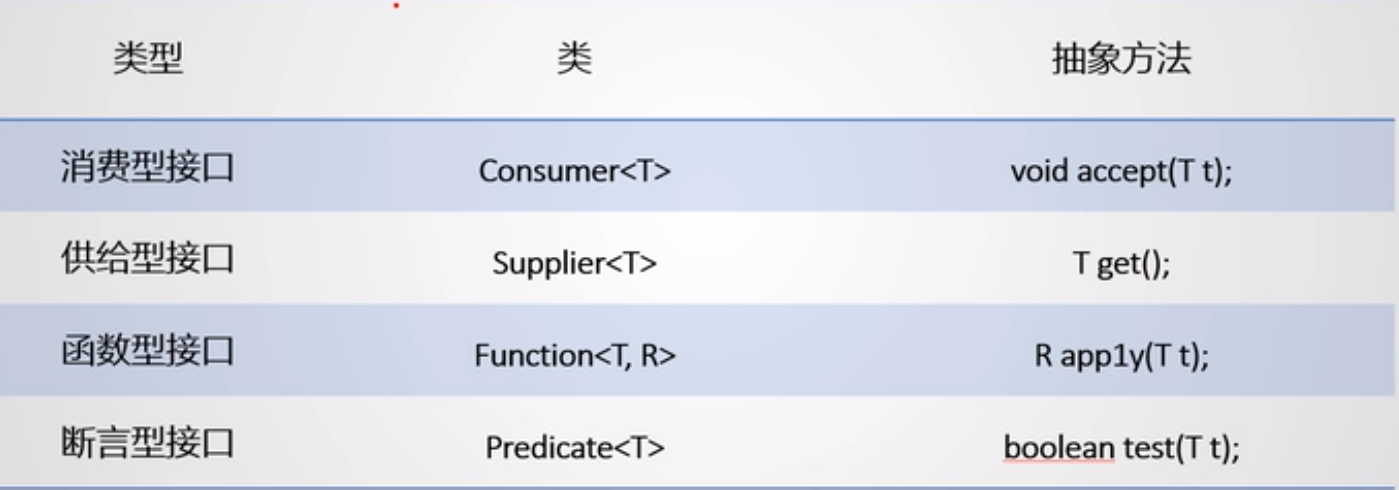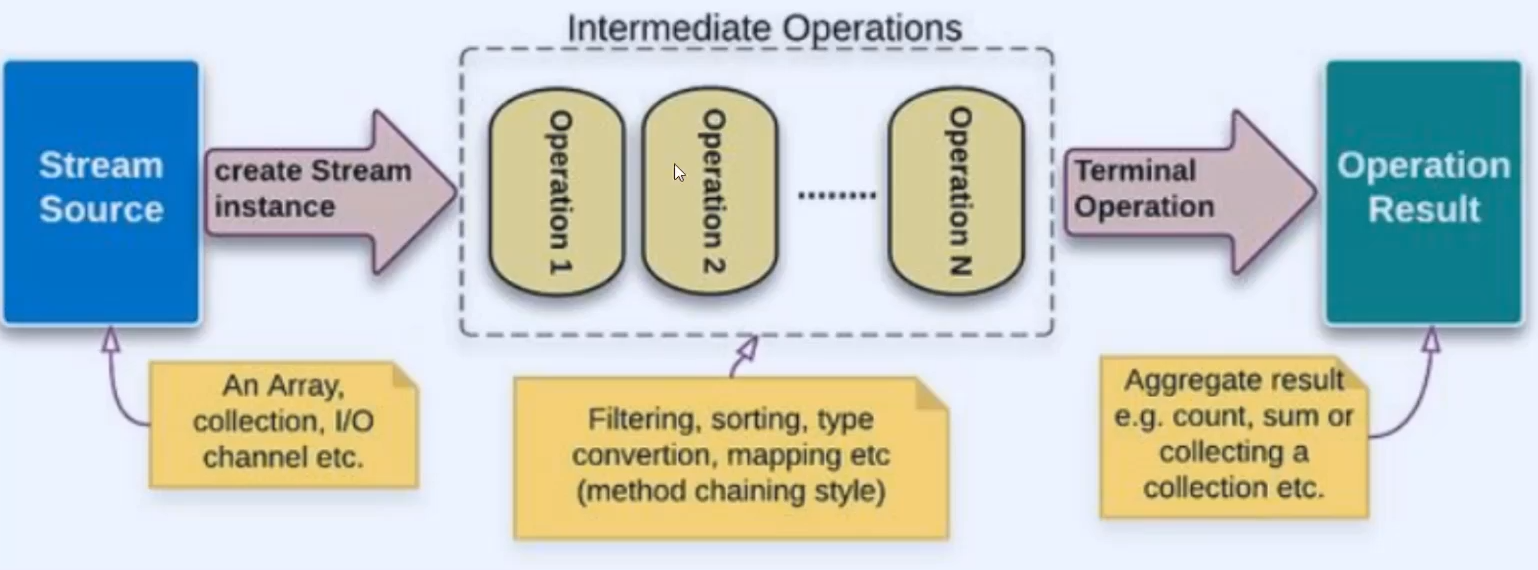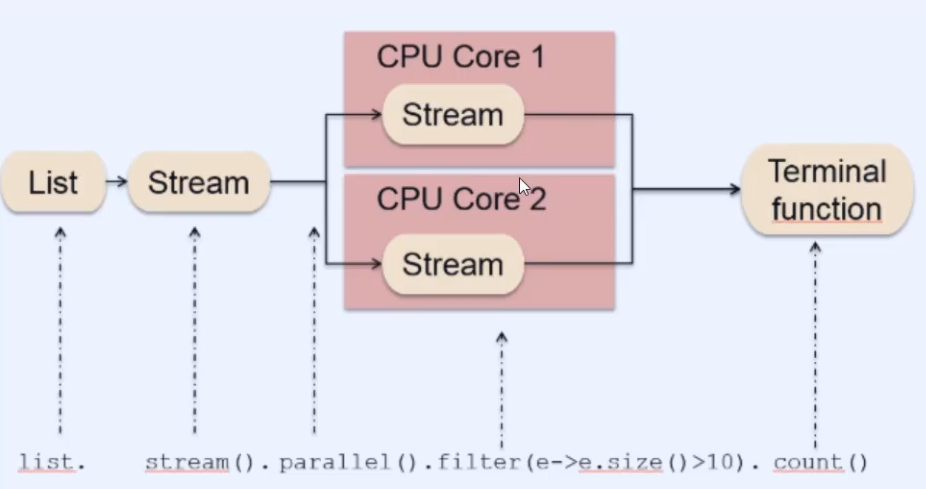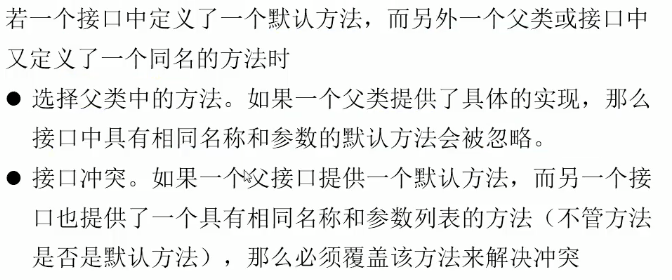1:Lambda 表达式
Lambda 表达式的标准格式为:
(参数类型 参数名称) ‐> { 代码语句 }
格式说明:
小括号内的语法与传统方法参数列表一致:无参数则留空;多个参数则用逗号分隔。对应于抽象方法的参数
-> 是新引入的语法格式,代表指向动作。
大括号内的语法与传统方法体要求基本一致。相当于对抽象方法的实现,函数式接口,只有一个抽象方法。
1.1:Lambda 语法糖
匿名函数,由编译器推断并帮你
解决了什么??
例一:
TreeSet
@Override
public int compare(Integer o1, Integer o2) {
return Integer.compare(o1,o2);
}
});
去掉多余的一模一样的架子
TreeSet
例二:自定义
1.2:六大语法
->lambda 操作符,左侧是 lambda 表达式的参数列表,右侧是所需执行的功能,依赖于函数式接口,lambda 表达式即对接口的实现
函数式接口:
使用注解@FunctionalInterface,该接口只有一个方法
语法 1:无参无返回值
//语法一:无参无返回值
Runnable runnable = new Runnable() {
@Override
public void run() {
System.out.println(“输出某些东西”);
}
};
//简化实现
Runnable runnable1 = ()->System.out.println(“输出某些东西”);
注意:匿名内部类使用外部的变量必须为 final,无法改变,即使没有声明,也是 final 的
语法二:有一个参数,无返回值
//语法二:有一个参数,无返回值
Consumer
@Override
public void accept(String s) {
System.out.println(s);
}
};
//简化实现
//如果只有一个参数,(x)也可以直接写成x
Consumer
com1.accept(“有一个参数,无返回值,输出参数”);
语法三:多个参数,有返回值,多条执行语句
//语法三:多个参数,有返回值,多条执行语句
Comparator
System.out.println(“执行某些操作”);
return Integer.compare(x,y);
};
//如果只有一条语句,return 和大括号都可以省略
Comparator
//语法六:参数指定类型
//语法三依然可以执行,是因为JVM的上下文推断
Comparator
1.3:四大内置函数

1.4:方法引用和构造器引用
若 lambda 体中的内容由方法已经实现了,我们可以使用方法引用
语法一
对象::实例方法名
抽象方法的参数类型与参数引用的参数类型一致
//以前
Employee emp = new Employee();
Supplier
String str = sup.get();//供给型接口的get()方法
System.out.println(str);
//现在:由于对象emp有实现
Supplier
语法二
类::静态方法名
Comparator
Comparator
语法三
类::实例方法名
当抽象方法第一个参数为实例方法的调用者,第二个参数为实例方法的参数
//以前
BiPredicate
//now
BigPrediacate
构造器引用
需要调用的构造器参数列表与函数式的构造列表保持一致。
ClassName::new
//供给型
Supplier
//构造器引用方式,自动匹配无参构造器
Supplier
Employee emp = sup.get();
法二
//函数形
Function
//构造器引用,自动匹配有参构造器
Function
Employee emp = sup.apply(101);
数组引用
Type[]::new
//函数型
Function
String[] str = fun.apply(10);
System.out.println(str.length);
//数组引用
Function
String[] str = fun.apply(20);
System.out.println(str.length);
lambda 表达式与方法引用的取舍?
优先使用 lambdas 表达式而不是匿名类
优先使用方法引用而不是 lambdas
lambdas 表达式能做到方法引用做不到的??
lambdas 表达式可以捕获外围词法的变量,但是方法引用不行,方法引用只能将其传进去。
方法引用更短更清楚的时候使用方法引用,,否则使用 lambdas 表示
2:Stream
字母哥的博客:你可能真的不懂 java
Stream 是 Java8 中处理集合的关键抽象概念,他可以指定你希望对集合进行的操作,可以执行非常复杂的查找,过滤和映射数据等操作。
接口的抽象方法的形参表,返回类型需要和调用的类方法的形参表,返回类型保持一致
image-20201128165317600
2.1:获取流
1:可以通过 Collection 系列集合提供的 stream()或者 parallelStream()
List
Stream
2:通过 Arrays 中静态方法 stream()获取数组流
Employee[] emps = new Employee[10];
Stream
3:通过 Stream 类的静态方法 of()
Stream
4:创建无限流
//迭代
Stream
Stream.limit(10).forEach(System.out::println);
//生成
Stream.generate(()->Math.random())
2.2:中间操作
中间操作不会执行任何操作其实,只有终止操作时才会一次性执行全部内容,成为惰性求值
2.2.1:筛选与切片
Filter 与谓词逻辑
谓词逻辑:比如 sql 语句中 WHERE 和 AND 限定了主语 employee 是什么,那么 WHERE 和 AND 语句所代表的逻辑就是谓词逻辑。
//创建Employee类,并创建10个对象
List
List
.filter(e->e.getAge()>70 && e.getGender = ‘M’)
.collect(Collectors.toList());
limit(n);截断流,使元素不超过给定数量
employee.stream()
.filter((e)->{
System.out.println(“!!”);
return e.getSalary()>5000;
})
.limit(2)
.forEach(System.out::println);
//发现只执行两次,主要满足2个条件就就此截断
skip(n);跳过元素,返回一个扔掉前 n 个元素的流
distinct—筛选,通过流生成元素的 hashCode()和 equals()去除重复元素
2.2.2:映射
map—接收 lambda,将元素转换成其他形式或提取信息,接收一个函数作为参数,该函数会被应用到每个元素上。
map 转换数据
//类型转换
Stream.of(“Monkey”, “Lion”, “Giraffe”, “Lemur”)
.mapToInt(String::length)
.forEach(System.out::println);
多步骤操作
List
.map(e -> {
e.setAge(e.getAge() + 1);
e.setGender(e.getGender().equals(“M”)?”male”:”female”);
return e;
}).collect(Collectors.toList());
//peek和map一样
List
.peek(e -> {
e.setAge(e.getAge() + 1);
e.setGender(e.getGender().equals(“M”)?”male”:”female”);
}).collect(Collectors.toList());
flatmap()处理多维数组
flatMap()接收一个函数作为参数,将流中的每个值都换成另一个流,然后把所有的流连接成一个流
//取出每个字符
public static Stream
List
for(Character ch:str.toCharArray()){
list.add(ch);
}
return list.stream();
}
public static main(String[] args){
Stream
stream.forEach((sm)->{
sm.forEach(System.out::println);
});
}
使用 flatMap
Stream
2.2.3:排序
sorted()——自然排序(Comparable)
sorted(Comparator com)——定制排序
list.stream()
.sorted()
.forEach(System.out::println);
emp.stream()
.sorted((e1,e2)->{
if(e1.getAge().equals(e2.getAge())){
return e1.getName().comparaTo(e2.getName());
}else{
return e1.getAge.compareTO(e2.getAge());
}
}).forEach(System.out::println);
Stream API 代替 for 循环
例:
List<String> nameStrs = Arrays.asList("Monkey","Lion","Giraffe","Lemur");List<String> list = nameStrs.stream().filter(s->s.startsWith("L"))//过滤以L开头的.map(String::toUpperCase)//map即对每个数据进行处理:调用String类的toUpperCase方法.sorted()//排序.collect(toList());//转换为list//数组转换成流String[] nameStrs1 = {"Monkey","Lion","Giraffe","Lemur"};Stream.of(nameStrs1).filter(s->s.startsWith("L")).map(String::toUpperCase);//SetSet<String> set = new HashSet<>(nameStrs);set.stream().filter(……)//文件Stream<String> stringStream = Files.lines(Paths.get("file.txt"));遍历二维数组Arrays.stream(result2).forEach(arr->{Arrays.stream(arr).filter(i->i!=0).forEach( i ->System.out.print(i));System.out.println();});问题??对于如下两个 for 循环,怎么改造?效率低了吗?for (int j = 0; j < n; j++) {result[j][0] = 1;}for (int i = 1; i < n; i++) {for (int j = 1; j < n; j++) {result[i][j] = result[i-1][j-1] + result[i-1][j];}}####有状态操作//取前两个List<String> limitN = Stream.of("Monkey", "Lion", "Giraffe", "Lemur").limit(2).collect(Collectors.toList());//跳过前两个List<String> skipN = Stream.of("Monkey", "Lion", "Giraffe", "Lemur").skip(2).collect(Collectors.toList());//去重List<String> uniqueAnimals = Stream.of("Monkey", "Lion", "Giraffe", "Lemur", "Lion").distinct().collect(Collectors.toList());
并行不要用有状态操作
并行操作
Stream.of(“Monkey”, “Lion”, “Giraffe”, “Lemur”, “Lion”)
.parallel()
.forEach(System.out::println);
2.3:终端操作
2.3.1:查找与匹配
allMatch()——检查是否匹配所有元素,返回 boolean
//是否所有元素的状态都是BUSY
boolean b = emplist.stream()
.allMatch((e)->e.getStatus().equals(Status.BUSY));
anyMatch——检查是否至少匹配一个元素
//是否存在状态为BUSY的元素
boolean b = emplist.stream()
.anyMatch((e)->e.getStatus().equals(Status.BUSY));
noneMatch——检查是否没有匹配所有元素
//是否没有状态为BUSY的元素
boolean b = emplist.stream()
.noneMatch((e)->e.getStatus().equals(Status.BUSY));
findFirst——返回第一个元素
//工资最高的
Optional
.sorted((e1,e2)->Double.compare(e1.getSalary(),e2.getSalary()))
.findFirst();
findAny——返回当前流中任意元素
count——返回流中元素总个数
max——返回流中最大值
min——返回流中最小值
2.3.2:归约
Stream.reduce可以将流中元素反复结合起来,得到一个值。
用来实现集合元素的归约。reduce 函数有三个参数:
- Identity 标识:一个元素,它是归约操作的初始值,如果流为空,则为默认结果。
- Accumulator 累加器:具有两个参数的函数:归约运算的部分结果和流的下一个元素。
- Combiner 合并器(可选):当归约并行化时,或当累加器参数的类型与累加器实现的类型不匹配时,用于合并归约操作的部分结果的函数
Integer 类型归约
reduce 初始值为 0,累加器可以是lambda表达式,也可以是方法引用。
List
int result = numbers
.stream()
.reduce(0, (subtotal, element) -> subtotal + element);
System.out.println(result); //21
int result = numbers
.stream()
.reduce(0, Integer::sum);
System.out.println(result); //21
String 类型归约
不仅可以归约 Integer 类型,只要累加器参数类型能够匹配,可以对任何类型的集合进行归约计算。
List
String result = letters
.stream()
.reduce(“”, (partialString, element) -> partialString + element);
System.out.println(result); //abcde
String result = letters
.stream()
.reduce(“”, String::concat);
System.out.println(result); //ancde
对象归约
List
Integer total = employees.stream().map(Employee::getAge).reduce(0,Integer::sum);
System.out.println(total); //346
2.3.3:收集
调用完终端操作就不能再用了,流已经关闭了
collect——将流转换为其他形式,接收一个 Collector 接口的实现,用于给 Stream 中元素汇总的方法。

//打印
Stream.of(“Monkey”, “Lion”, “Giraffe”, “Lemur”, “Lion”)
.parallel()
.forEach(System.out::println);
Stream.of(“Monkey”, “Lion”, “Giraffe”, “Lemur”, “Lion”)
.parallel()
.forEachOrdered(System.out::println);
//收集
.collect(Collectors.toSet());
.collect(Collectors.toList());
.collect(Collectors.toCollection(LinkedList::new));
.toArray(String[]::new);
.collect(Collectors.toMap(
Function.identity(), //元素输入就是输出,作为key
s -> (int) s.chars().distinct().count()// 输入元素的不同的字母个数,作为value
));
// 最终toMap的结果是: {Monkey=6, Lion=4, Lemur=5, Giraffe=6}
.collect(Collectors.groupingBy(
s -> s.charAt(0) , //根据元素首字母分组,相同的在一组
// counting() // 加上这一行代码可以实现分组统计
));
// 最终groupingByList内的元素: {G=[Giraffe], L=[Lion, Lemur, Lion], M=[Monkey]}
//如果加上counting() ,结果是: {G=1, L=3, M=1}
boolean containsTwo = IntStream.of(1, 2, 3).anyMatch(i -> i == 2);
// 判断管道中是否包含2,结果是: true
long nrOfAnimals = Stream.of(
“Monkey”, “Lion”, “Giraffe”, “Lemur”
).count();
// 管道中元素数据总计结果nrOfAnimals: 4
int sum = IntStream.of(1, 2, 3).sum();
// 管道中元素数据累加结果sum: 6
OptionalDouble average = IntStream.of(1, 2, 3).average();
//管道中元素数据平均值average: OptionalDouble[2.0]
int max = IntStream.of(1, 2, 3).max().orElse(0);
//管道中元素数据最大值max: 3
IntSummaryStatistics statistics = IntStream.of(1, 2, 3).summaryStatistics();
// 全面的统计结果statistics: IntSummaryStatistics{count=3, sum=6, min=1, average=2.000000, max=3}
2.4:并行流
对于 stream 性能方面
1:测试性能的方法
使用 junitperf
int 的是 for 循环效率更高,否则更高
函数式接口 Comparator
Stream 查找匹配规则
并行流
Integer total2 = employees
.parallelStream()
.map(Employee::getAge)
.reduce(0,Integer::sum,Integer::sum); //注意这里reduce方法有三个参数
System.out.println(total); //346
3:空指针异常 optional


4:接口中的默认方法和静态方法
接口中以前只能有全局静态常量和抽象方法
现在可以拥有默认方法
public interface MyFun{
default String getName(){
return “1234”;
}
}
这样就会出现冲突
接口默认方法的“类优先”原则,优先继承
静态方法
public interface MyFun{
default String getName(){
return “1234”;
}
public static void show(){
System.out.println(“静态方法”);
}
}
5:全新日期与时间
不可变的,线程安全,都在 java.time 包下
距离 1970 年的毫秒数
5.1
日期:LocalDate : 时间:LocalTime :日期时间:LocalDateTime
三个类的方法大体一样,以最全的 LocalDateTime 为例
//获取当前系统时间
LocalDateTime ldt = LocalDateTime.now();
System.out.println(ldt);
//输出:2020-12-02T09:11:37.247
构造时间
LocalDateTime ldt = LocalDateTime.of(2020,12,01,13,22,33);
System.out.println(ldt);
//输出:2020-12-01T13:22:33
加时间,减时间
// 在该日期时间基础上增加或减少一定时间,
// 参数1:时间量,可以是负数,参数2:时间单位
LocalDateTime plus = parse.plus(1L, ChronoUnit.HOURS); // 2019-10-17T17:54:50.941
// LocalDateTime plus(TemporalAmount amountToAdd):在该时间基础上增加一定时间
LocalDateTime plus1 = parse.plus(Period.ofDays(1)); // 2019-10-18T16:54:50.941
LocalDateTime plus2 = parse.plusDays(1L); // 2019-10-18T16:54:50.941
// LocalDateTime plusDays(long days):增加指定天数
// LocalDateTime plusHours(long hours):增加指定小时数
// LocalDateTime plusMinutes(long minutes):增加指定分钟数
// LocalDateTime plusMonths(long months):增加指定月份数
// LocalDateTime plusNanos(long nanos):增加指定毫秒数
// LocalDateTime plusSeconds(long seconds):增加指定秒数
// LocalDateTime plusWeeks(long weeks):增加指定周数
// LocalDateTime plusYears(long years):增加指定年数
//获取拆分
ldt.getYear();
ldt.getMonthValue();
ldt.getDayOfMonth();
ldt.getHour();
ldt.getMinute();
ldt.getSencond();
5.2:Instant 时间戳
以 unix 元年:1970 年 1 月 1 日到某个时间之间的毫秒值
Instant ins = Instant.now();//默认获取的不是系统时间,而是格林威治时区时间
System.out.println(ins);
//偏移量,偏移8个时区
OffsetDateTime odt = ins.atOffset(ZoneOffset.ofHours(8));
System.out.println(odt);
//输出:2020-12-01T13:22:33+8:00
//获取毫秒时间
System.out.println(ins.toEpochMilli());
6:重复注解和类型注解
Java 8 引入了充足注解的概念,允许在同一个地方多次使用同一个注解。在 Java 8 中使用@Repeatable注解定义重复注解
Java 8 拓宽了注解的应用场景。现在,注解几乎可以使用在任何元素上:局部变量、接口类型、超类和接口实现类,甚至可以用在函数的异常定义上。
3:HashMap 的实现
当碰撞达到一定的设置值(默认碰撞长度为 8,总长度大于 64)时,会将链表转换成红黑树
红黑树,除了插入其他操作都比链表快,扩容时元素位置变到
ConcurrentHashMap 同样也变了
以前使用锁分段机制,现在使用 CAS 算法
4:JVM 结构的变化
元空间——OOM 发生的几率就低了

